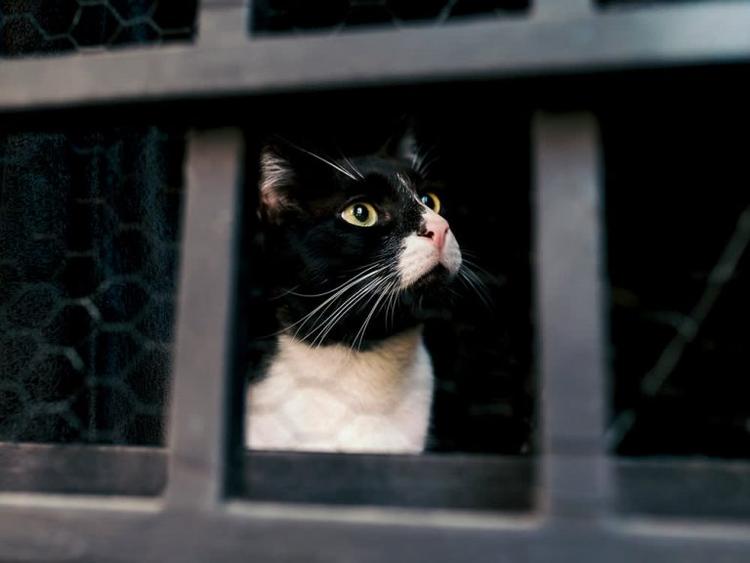Everything You Need to Know About Adopting a Stray Cat
With some patience and a well-informed approach, it is absolutely possible to adopt a stray cat.
With some patience and a well-informed approach, it is absolutely possible to adopt a stray cat.
by Mollie Jackman, | July 19, 2024

fotofabrika / Adobe Stock
If you’re an animal person, you’ve probably encountered plenty of stray or abandoned cats, and maybe even tried to befriend a few. But when it comes to making a stray part of the family, where do you start? While it may be tempting to simply give them a name and bring them inside, there are actually a few important steps to take first.
Here, we’ll go over those steps, as well as some specific stray cat issues you may face during the process. But don’t worry, because the bond you’ll form with a cat you’ve personally rescued is one of the strongest — and it’s well worth the effort.
We’ve all seen movies and TV shows where people find a pet and instantly decide to keep it — but in reality, it’s important to verify a few things first. You can adopt a stray cat, as long as you follow the proper steps and followed any local protocols.
Note: The steps for what to do when you find a pregnant stray cat are a bit different, and they should be approached with care.
Here are the proper steps to follow, keeping in mind that they may vary according to your location.
Verify that the cat is a stray: It’s first important to check if the cat already has a pet parent, by visiting a vet or animal shelter to scan for a microchip. Check for a collar, tags, or other signs of ownership. This includes searching lost-pet forums and social-media pages.
Report the cat to authorities: Contact local animal control or shelters to report a found cat. This ensures that pet parents have the best chance to reclaim their lost cat.
Stray hold period: Read up and comply with local stray hold laws, which may require that a cat be held for a certain period (usually five to seven days) before they can be adopted.
Provide temporary care: If allowed, offer to foster the cat during the holding period. Ensure the cat is well-fed, comfortable, and safe while waiting to see if a pet parent steps forward.
Adopt the cat: Once you’ve gone through the proper channels, you’re clear to adopt your new pet. Make sure to schedule a health check-up, vaccinations, and a spay or neuter appointment ASAP. They’ll likely need to be vaccinated and treated for any parasites, and they may need a gradual introduction to life as an indoor cat.
Help the cat adjust: Next, you’ll need patience, understanding, and a safe, quiet space for your new family member to acclimate to their new surroundings. With some time and lots of love, a stray cat can become a wonderful pet.
Let’s recognize the benefits of adopting a stray cat. Here are just a few.
Saving a life: Adopting a stray cat gives them a second chance at life, especially for less adoptable pets such as strays.
Unique personality: Stray cats often have unique, resilient personalities due to their experiences. Through adoption, you can welcome a spirited companion into your home who will provide endless joy and entertainment.
Gratitude and affection: Once your new cat acclimates to your home, they’ll likely show their gratitude and affection in one way or another. While not all cats love to cuddle, they may express their love by bringing you little gifts or asking you to play.
Reducing shelter burden: When you adopt a stray, you help reduce the strain on animal shelters and rescues.
Community contribution: Adopting a stray cat helps address the overpopulation of strays in your community. You can also set an example for others by
Building a strong bond: Knowing your cat’s origin story and helping them transition from a stray to a beloved pet can create an extremely deep connection between the two of you.
If you’re already wondering, “Should I adopt a stray cat?” — you may have already even found a stray cat you want to adopt. But it’s important to prepare for all that love and fun. Let’s go over a few of the most common concerns, and how to approach them.
Whether you need to know how to help a stray injured cat or just need to know the steps to take when bringing one home, it’s important to address their health first. Adopting a stray cat can mean dealing with various health issues. Strays are often exposed to harsh environments that lead to malnutrition, parasites, infections, and diseases. Some of these can lead to ongoing conditions that require medication or special diets. These health challenges can be persistent and come with significant costs, so it’s important to be financially prepared.
The good news is that veterinarians are well-versed in stray-cat health issues and can easily diagnose and treat them, even if it takes some time. (As the pet parent to a former stray cat who had to be dewormed four times, I can personally attest to this one.) But once you’re established, regular vet visits can keep your cat healthy. You’ll also have a thorough and detailed history of your pet’s health from the very beginning.
Stray cats may behave differently from most cats you’ve met. Many stray cats have spent their whole lives without regular human interaction. They can be fearful, anxious, or even aggressive toward new people, which can make for a challenging adjustment period for both you and your cat.
Luckily with patience, a gradual introduction to their new environment can help mitigate these issues. Creating a safe, quiet space — where your cat can retreat to — can help them feel secure. It’s important not to force social interaction, and let your cat come to you for affection when they’re ready. With consistent routines and positive reinforcement, you’ll slowly build trust and develop a more social relationship. You can also consult a cat behaviorist if you find the process more challenging than you can handle alone. (Yes, cat behaviorists are a thing.)
Bringing a stray cat into a home with existing pets can be tough, especially if the cat is not accustomed to living with other animals. Cats are solitary animals by nature, so it’s often hard for older strays to adjust to a more social environment. This can lead to stress and conflict among furry family members.
Introducing your new cat to your other pets should be done very gradually. Start by keeping them in separate areas and allowing them to get used to each others’ scents. Controlled, supervised meetings can help ease the transition, but be aware that it can take months to even years for some pets to acclimate to each other. This was the case in our household, where our older cat and young stray cat had trouble at first. Providing plenty of resources like food, litter boxes, and toys can reduce competition. Interactive toys are also a great way to provide an outlet for excess energy that can lead to conflicts. High spaces are likewise key for providing any cats in the household with an escape where they can observe their surroundings.
You’ll need to learn how to help a scared stray cat feel at home. Even if stray cats have had experiences with people, those interactions may not have all been good. They may be wary of new people and environments, and take more time to build a strong bond.
Building trust requires time and patience (and often lots of treats). Allow your new cat to approach you on their terms, offering food and speaking softly to create positive associations. Spend time sitting quietly near them, set their food bowls next to you at feeding time, and use interactive toys to bond through play. Over time, your cat will learn to associate you with safety, comfort, and fun.
Many cats, even strays, will naturally use a litter box once it’s introduced to them. But cats without previous experience may have a hard time understanding the concept, which can be frustrating to pet parents.
To overcome litter-box training challenges, start by placing the box in a quiet, easily accessible area. Show your cat where the box is, and gently place them inside it if they’re comfortable enough to be picked up. Keep the box clean and use unscented, soft litter. You can also try using litter attractants if your cat isn’t quite picking up on the idea. Offering praise and treats when they use the box correctly can encourage them to use it more. If issues persist, it’s a good idea to consult your vet to rule out any medical issues like UTIs or pain.
When you adopt a cat from a shelter or rescue, you typically pay a one-time adoption fee that covers all their vaccinations, spay/neuter, and sometimes even their first vet visit. So how much does it cost to adopt a stray cat? It will typically cost more, as you’ll need to pay for these services out of pocket:
Vet examination
Parasite treatment
Spay/neuter
Treatment of other health issues
Planning and budgeting can help you manage the financial aspects of adopting a stray cat, but you’ll definitely need some cash on hand to take on the challenge. Do plenty of research to find affordable vet care, food, and supplies, and see if there are any low-cost services in your area for stray animals. Once you’ve adopted a stray cat, consider taking out pet insurance to cover any unforeseen health issues that may arise.
Adopting a stray cat is a profoundly rewarding experience that brings unique joys and lifelong companionship. While there are challenges, the bond formed through shared history and feline gratitude makes every effort worthwhile. By adopting a stray, you not only save a life but also help your community. The journey of helping a stray become a beloved pet is filled with moments of triumph and affection, making it a uniquely fulfilling endeavor.
When you find a stray cat, you first need to identify whether it is truly a stray, or if it’s a feral cat. Once you’ve established this, you should check if the cat is lost and already has pet parents, following local protocols before attempting to adopt or rehome the cat. Learn more in our article on What to Do with a Stray Cat.
If you find a lost cat, you’ll want to start by searching for their pet parent. This includes calling local shelters, posting on forums and social media, and even making physical flyers if you can. If you find the cat’s pet parent, they can be reunited. If no pet parent is found, you can either adopt the cat yourself, surrender them to a shelter or rescue, or find a new home for them on your own.

Mollie Jackman is a writer, editor, and graduate of Lindenwood University’s MFA in writing. She’s also a pet parent to a goofy big-eared dog and two brown tabby cats, plus a rotating cast of foster animals. When she’s not reading, writing, or picking up strays, she can be found binge-watching arguably terrible reality TV shows and cooking competitions or rolling around the local skating rink in Columbia, Missouri.

Rehome

Foster & Volunteer

Foster & Volunteer


Adoption Advice
The benefits and challenges of adopting an outdoor cat, plus tips to keep them happy and healthy

Rehome
Nobody wants to part with their beloved pet — and you don’t have to. Here are some practical solutions to consider before assuming your cat isn’t working out.

Shelters & Rescue
Not every cat will be a match for you (and vice versa). Here’s how to find “the one.”

Rehome
Found a stray cat? Follow these steps to ensure their well-being while you search for their people.
